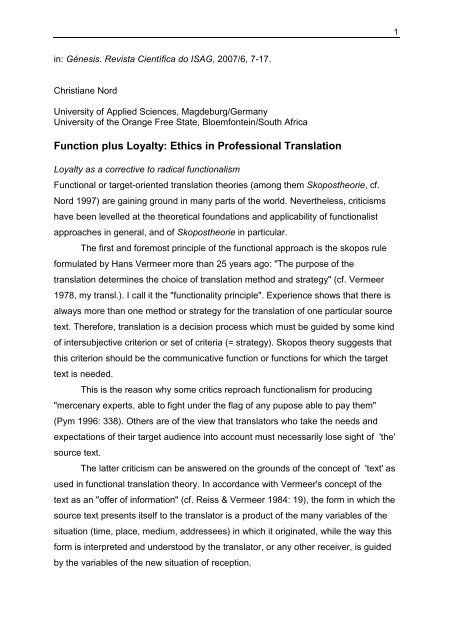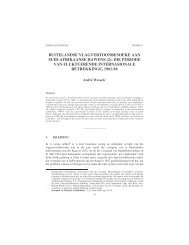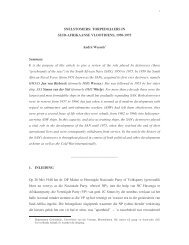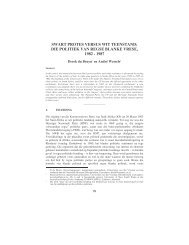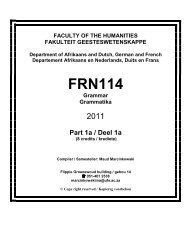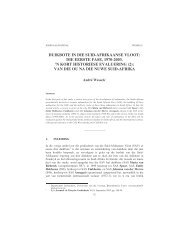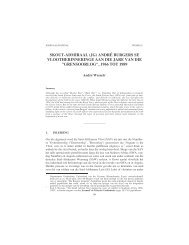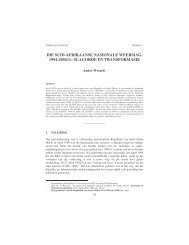Function plus Loyalty: Ethics in Professional Translation
Function plus Loyalty: Ethics in Professional Translation
Function plus Loyalty: Ethics in Professional Translation
You also want an ePaper? Increase the reach of your titles
YUMPU automatically turns print PDFs into web optimized ePapers that Google loves.
<strong>in</strong>: Génesis. Revista Científica do ISAG, 2007/6, 7-17.<br />
Christiane Nord<br />
University of Applied Sciences, Magdeburg/Germany<br />
University of the Orange Free State, Bloemfonte<strong>in</strong>/South Africa<br />
<strong>Function</strong> <strong>plus</strong> <strong>Loyalty</strong>: <strong>Ethics</strong> <strong>in</strong> <strong>Professional</strong> <strong>Translation</strong><br />
<strong>Loyalty</strong> as a corrective to radical functionalism<br />
<strong>Function</strong>al or target-oriented translation theories (among them Skopostheorie, cf.<br />
Nord 1997) are ga<strong>in</strong><strong>in</strong>g ground <strong>in</strong> many parts of the world. Nevertheless, criticisms<br />
have been levelled at the theoretical foundations and applicability of functionalist<br />
approaches <strong>in</strong> general, and of Skopostheorie <strong>in</strong> particular.<br />
The first and foremost pr<strong>in</strong>ciple of the functional approach is the skopos rule<br />
formulated by Hans Vermeer more than 25 years ago: "The purpose of the<br />
translation determ<strong>in</strong>es the choice of translation method and strategy" (cf. Vermeer<br />
1978, my transl.). I call it the "functionality pr<strong>in</strong>ciple". Experience shows that there is<br />
always more than one method or strategy for the translation of one particular source<br />
text. Therefore, translation is a decision process which must be guided by some k<strong>in</strong>d<br />
of <strong>in</strong>tersubjective criterion or set of criteria (= strategy). Skopos theory suggests that<br />
this criterion should be the communicative function or functions for which the target<br />
text is needed.<br />
This is the reason why some critics reproach functionalism for produc<strong>in</strong>g<br />
"mercenary experts, able to fight under the flag of any pupose able to pay them"<br />
(Pym 1996: 338). Others are of the view that translators who take the needs and<br />
expectations of their target audience <strong>in</strong>to account must necessarily lose sight of 'the'<br />
source text.<br />
The latter criticism can be answered on the grounds of the concept of 'text' as<br />
used <strong>in</strong> functional translation theory. In accordance with Vermeer's concept of the<br />
text as an "offer of <strong>in</strong>formation" (cf. Reiss & Vermeer 1984: 19), the form <strong>in</strong> which the<br />
source text presents itself to the translator is a product of the many variables of the<br />
situation (time, place, medium, addressees) <strong>in</strong> which it orig<strong>in</strong>ated, while the way this<br />
form is <strong>in</strong>terpreted and understood by the translator, or any other receiver, is guided<br />
by the variables of the new situation of reception.<br />
1
The first criticism, however, refers to an ethical quality related to the status of<br />
the source text. While narrower l<strong>in</strong>guistic approaches still praise the autonomy or<br />
authority of a source text, which must not be touched <strong>in</strong> the translation process,<br />
skopos theory no longer considers the source text, or more precisely, its l<strong>in</strong>guistic<br />
and stylistic features, to be a valid yardstick for a translation. Does this mean that the<br />
translator is entitled to do as he or she likes with the source text?<br />
Indeed, the functionality pr<strong>in</strong>ciple might be paraphrased as ‘the translation<br />
purpose justifies the translation procedures’, and this could easily be <strong>in</strong>terpreted as<br />
‘the end justifies the means’. Then there would be no restriction to the range of<br />
possible ends; the source text could be manipulated as clients (or translators) see fit.<br />
In a general theory, this doctr<strong>in</strong>e might be acceptable enough, s<strong>in</strong>ce one could<br />
always argue that general theories do not have to be directly applicable. Yet<br />
translation practice does not take place <strong>in</strong> a void. It takes place <strong>in</strong> specific situations<br />
set <strong>in</strong> specific cultures. Therefore, any application of the general theory, either to<br />
practice or to tra<strong>in</strong><strong>in</strong>g, has to consider the specific cultural conditions <strong>in</strong> which a text<br />
is translated.<br />
At different times and <strong>in</strong> different parts of the world, people have had and still<br />
have different concepts of the relationship that should hold between an orig<strong>in</strong>al and<br />
the text that is called its translation. Accord<strong>in</strong>g to the prevail<strong>in</strong>g concept of translation,<br />
readers might expect, for example, the target text to give exactly the author's op<strong>in</strong>ion;<br />
other cultures might want it to be a faithful reproduction of the formal features of the<br />
source text; still others could praise archais<strong>in</strong>g translations or ones that are far from<br />
faithful reproductions, but are comprehensible, readable texts. Tak<strong>in</strong>g account of all<br />
these different expectations, which may vary accord<strong>in</strong>g to the text type <strong>in</strong> question or<br />
depend on the self-esteem of the receiv<strong>in</strong>g culture with regard to the source culture,<br />
the translator acts as a responsible mediator <strong>in</strong> the cooperation develop<strong>in</strong>g between<br />
the client, the target audience and the source-text author. This does not mean that<br />
translators always have to do what the other parties expect, which may even be<br />
impossible if the three parties expect different translational behaviours. It means that<br />
the translator has to anticipate any misunderstand<strong>in</strong>g or communicative conflict that<br />
may occur due to different translational concepts and f<strong>in</strong>d a way to avoid them.<br />
This responsibility that translators have toward their partners is what I call<br />
'loyalty'. The loyalty pr<strong>in</strong>ciple was first <strong>in</strong>troduced <strong>in</strong>to Skopostheorie <strong>in</strong> 1989 (Nord<br />
1989, cf. Nord 1997:123ff.) <strong>in</strong> order to account for the culture-specificity of translation<br />
2
concepts, sett<strong>in</strong>g an ethical limitation to the otherwise unlimited range of possible<br />
skopoi for the translation of one particular source text. It was argued that translators,<br />
<strong>in</strong> their role as mediators between two cultures, have a special responsibility both<br />
with regard to their partners, i.e. the source-text author, the client or commissioner of<br />
the translation, and the target-text receivers, and towards themselves, precisely <strong>in</strong><br />
those cases where there are differ<strong>in</strong>g views as to what a 'good' translation is or<br />
should be. As an <strong>in</strong>terpersonal category referr<strong>in</strong>g to a social relationship between<br />
<strong>in</strong>dividuals who expect not to be betrayed <strong>in</strong> the process, loyalty may replace the<br />
traditional <strong>in</strong>tertextual relationship of 'fidelity', a concept that usually refers to a<br />
l<strong>in</strong>guistic or stylistic similarity between the source and the target texts, regardless of<br />
the communicative <strong>in</strong>tentions and/or expectations <strong>in</strong>volved. It is the translator's task<br />
to mediate between the two cultures, and I believe that mediation can never mean<br />
the imposition of the concept of one culture on members of another.<br />
In <strong>in</strong>troduc<strong>in</strong>g the loyalty pr<strong>in</strong>ciple <strong>in</strong>to the functionalist model, I would<br />
therefore also hope to lay the foundations for a trust<strong>in</strong>g relationship between the<br />
partners <strong>in</strong> the translational <strong>in</strong>teraction. If authors can be sure that translators will<br />
respect their communicative <strong>in</strong>terests or <strong>in</strong>tentions, they may even consent to any<br />
changes or adaptations needed to make the translation work <strong>in</strong> the target culture.<br />
And if clients or receivers can be sure that the translator will consider their<br />
communicative needs as well, they may even accept a translation that is different<br />
from what they expected. This confidence will then strengthen the translator's social<br />
prestige as a responsible and trustworthy partner.<br />
The loyalty pr<strong>in</strong>ciple thus adds two important qualities to the functional<br />
approach. S<strong>in</strong>ce it obliges the translator to take account of the difference between<br />
culture-specific concepts of translation prevail<strong>in</strong>g <strong>in</strong> the two cultures <strong>in</strong>volved <strong>in</strong> the<br />
translation process, it turns Skopostheorie <strong>in</strong>to an anti-universalist model; and s<strong>in</strong>ce it<br />
<strong>in</strong>duces the translator to respect the sender's <strong>in</strong>dividual communicative <strong>in</strong>tentions, as<br />
far as they can be elicited, it reduces the prescriptiveness of 'radical' functionalism.<br />
Seen <strong>in</strong> this light, the functionality pr<strong>in</strong>ciple must be complemented by the<br />
"loyalty pr<strong>in</strong>ciple", which says that the acceptability of translation purposes is limited<br />
by the translator's responsibility to all her or his partners <strong>in</strong> the cooperative activity of<br />
translation. <strong>Loyalty</strong> may oblige translators to reveal their translation purposes and<br />
justify their translational decisions.<br />
3
In what follows, I will illustrate this po<strong>in</strong>t by means of few examples from the<br />
new German translation of the New Testament published <strong>in</strong> 1999, which was<br />
produced <strong>in</strong> close cooperation between my husband, Klaus Berger, a New<br />
Testament scholar of Heidelberg University, and myself.<br />
Bridg<strong>in</strong>g coherence gaps (Jas. 1,14-18)<br />
Quite a few New Testament scholars have considered the Epistle of James to be a<br />
collection of <strong>in</strong>coherent statements. But as recent research has found out, the<br />
apparent <strong>in</strong>coherence may be due to the fact that metaphors of procreation and birth<br />
are not as familiar to modern readers as as they were to the addressees of the writer<br />
of this letter, as we may guess from other texts draw<strong>in</strong>g on the same fundamental<br />
human experience. If coherence works through the comb<strong>in</strong>ation of what is verbalized<br />
<strong>in</strong> a text and what is presupposed to be part of the audience's previous knowledge,<br />
as pragmatic text l<strong>in</strong>guistics have taught us, the balance between verbalized (i.e.<br />
explicit) and presupposed (i.e. implicit) <strong>in</strong>formation may have to be shifted if the<br />
message is to be coherent for an audience whose previous knowledge is different<br />
from that of the orig<strong>in</strong>al addressees.<br />
Example 1: Coherence<br />
BSP (no year) DNT 1999:76 Engl. Transl. of DNT 1999<br />
(14) Ao contrário, cada<br />
um é tentado pela sua<br />
própria cobiça, quando<br />
esta o atrai e seduz.<br />
15) Então a cobiça,<br />
depois de haver<br />
concebido, dá à luz o<br />
pecado; e o pecado, uma<br />
vez consumado gera a<br />
morte.<br />
(16) Não vos enganeis,<br />
meus amados irmãos.<br />
(17) Toda boa dádiva e<br />
todo dom perfeito é lá do<br />
alto, descendo do Pai das<br />
luzes, em quem não pode<br />
existir variação, ou<br />
sombra de mudança.<br />
(18) Pois, segundo os<br />
(14) Wenn man sich zu bewähren<br />
hat, dann immer und ausschließlich<br />
gegenüber der eigenen<br />
Triebhaftigkeit, die an jedem<br />
e<strong>in</strong>zelnen zerrt oder ihn ködert.<br />
(15) Das Ganze ist dann wie<br />
zweifaches Zeugen und Gebären:<br />
Die Triebhaftigkeit des Menschen<br />
ist wie e<strong>in</strong> Mutterschoß,<br />
der den bösen Gedanken empfängt<br />
und die böse Tat gebiert.<br />
Die böse Tat ihrerseits wird reif<br />
und wächst sich aus, und sie<br />
gebiert den Tod. (16) Macht euch<br />
über diesen schrecklichen Zusammenhang<br />
ke<strong>in</strong> e falschen<br />
Vorstellungen! (17) Aber Ähnliches<br />
gilt auch von der Gegenseite:<br />
Alles, was gut und bewundernswert<br />
ist, kommt vom Himmel<br />
als Geschenk von Gott, dem<br />
Vater der Lichter, der unveränderlich<br />
ist und nicht den kle<strong>in</strong>sten<br />
Hauch des Wandels zeigt. (18)<br />
Auch hier gibt es Zeugung und<br />
(14) Whenever we have to<br />
prove our firmness it is<br />
solely aga<strong>in</strong>st our own<br />
desire, by which each of us<br />
is drawn away and enticed.<br />
(15) The whole process is<br />
like a twofold procreation:<br />
Human desire is like a womb<br />
that conceives the bad<br />
thought and br<strong>in</strong>gs forth the<br />
bad deed. The bad deed<br />
then grows to maturity and<br />
br<strong>in</strong>gs forth death.<br />
(16) Don't fool yourselves<br />
about this terrible sequence<br />
of events!<br />
(17) But the same is true of<br />
the opposite: Everyth<strong>in</strong>g that<br />
is good and worth admir<strong>in</strong>g<br />
comes down from heaven,<br />
as a gift from God, the father<br />
of lights, who is stable and<br />
never shows the slightest<br />
trace of change. (18) Here is<br />
4
seu querer, ele nos gerou<br />
pela palavra da verdade,<br />
para que fôssemos como<br />
que primícias das suas<br />
criaturas.<br />
Geburt: Gott wollte uns; durch<br />
das Wort der Wahrheit hat er uns<br />
als se<strong>in</strong>e Wunschk<strong>in</strong>der <strong>in</strong> die<br />
Welt gesetzt, als Erstl<strong>in</strong>ge se<strong>in</strong>er<br />
[neuen] Schöpfung.<br />
procreation too: God wanted<br />
us; through the Word of<br />
Truth, he brought us <strong>in</strong>to the<br />
world as his longed-for<br />
children, as firstborn creatures<br />
of his [new] creation.<br />
Traditional translations of this passage (BSP, the Brazilian version by Pereira de<br />
Figueiredo, is by no means an exception and stands for many others) leave the text<br />
as it stands <strong>in</strong> the Greek orig<strong>in</strong>al, thus produc<strong>in</strong>g the impression of a series of<br />
unconnected utterances. In our translation, which has been back-translated for the<br />
purpose of this paper, the coherence gaps have been 'filled' by means of cohesive<br />
devices, as they are quite common <strong>in</strong> difficult argumentative texts: cataphoric<br />
references <strong>in</strong>dicat<strong>in</strong>g the ma<strong>in</strong> po<strong>in</strong>t of the follow<strong>in</strong>g passages (verse 15, 17, 18 with<br />
a colon at the end), anaphoric references to the preced<strong>in</strong>g passage (verse 16: "this<br />
terrible sequence of events"), connectors (verse 17: "the opposite"), explicitation of<br />
the metaphor by means of a simile (verse 15: "like a womb"), and a number of<br />
parallel constructions. These cohesion markers guide the reader's comprehension<br />
whithout be<strong>in</strong>g additions to the message. S<strong>in</strong>ce modern readers cannot be expected<br />
to be familiar with the idea of the 'old' creation be<strong>in</strong>g replaced by a new and better<br />
one which starts with the birth of Jesus, we added the adjective "new" <strong>in</strong> verse 18.<br />
This addition is marked by square brackets.<br />
Strange words for strange th<strong>in</strong>gs<br />
The skopos of our translation was to make otherness understood, not to turn it <strong>in</strong>to<br />
sameness. Therefore, where the source text refers to source-culture realities, we<br />
sometimes decided to create a new word rather than to use a word that suggests a<br />
reference to target-culture reality. In the Gospel of St. Mark, Mk. 2,18-19, for<br />
example. we used a neologism, Vorhochzeit ('pre-wedd<strong>in</strong>g'), to refer to the time<br />
before the wedd<strong>in</strong>g dur<strong>in</strong>g which the bridegroom is celebrat<strong>in</strong>g with his (male!)<br />
friends. The neologism was formed <strong>in</strong> analogy with exist<strong>in</strong>g words denot<strong>in</strong>g 'the<br />
period before a certa<strong>in</strong> event', e.g. Vorweihnachtszeit, 'the period before Christmas'.<br />
The unusual word was meant precisely to avoid quick equations with similar rituals <strong>in</strong><br />
the target culture, and at the same time to make clear that it is not yet the wedd<strong>in</strong>g<br />
day, as is suggested <strong>in</strong> various translations which use words like wedd<strong>in</strong>g guests and<br />
bridegroom or its equivalents (cf. GNB 1997: Hochzeitsgäste, Bräutigam; NTF 1922:<br />
5
les garçons des neces, l'épous; SBE 1964: los <strong>in</strong>vitados a bodas, el esposo; BSB<br />
1982: os amigos do noivo, o noivo).<br />
Example 2: Pre-wedd<strong>in</strong>g<br />
BSP DNT 1999:76 Engl. Transl. of DNT 1999<br />
(18) Ora, os discípulos e<br />
Joã e os fariseus<br />
estavam jejuando. Vieram<br />
alguns e lhe<br />
perguntaram: Por que<br />
motivo jejuam os<br />
discípulos de João e dos<br />
fariseus, mas os teus<br />
discípulos não jejuam?<br />
(19) Respondeu-lhes<br />
Jesus: Podem,<br />
porventura, jejuar os<br />
convidados para o<br />
casamento, enquanto o<br />
noivo está com eles?<br />
(18) Die Jünger des Johannes<br />
und der Pharisäer hielten bestimmte<br />
Fastengebote e<strong>in</strong>. Daher<br />
traten Neugierige an Jesus<br />
mit der Frage heran: ‘Warum<br />
halten die Jünger des Johannes<br />
und der Pharisäer Fastengebote<br />
e<strong>in</strong>, de<strong>in</strong>e Jünger aber<br />
nicht?’ (19) Jesus erwiderte:<br />
‘Können etwa die künftigen<br />
Hochzeitsgäste <strong>in</strong> der Zeit<br />
Fastengebote e<strong>in</strong>halten, wenn<br />
der künftige Bräutigam mit<br />
ihnen schon die Vorhochzeit<br />
feiert?’<br />
"False friends" with severe consequences<br />
(18) The disciples of John and<br />
of the Pharisees used to keep<br />
certa<strong>in</strong> fast<strong>in</strong>g periods.<br />
Therefore, some people<br />
asked Jesus out of curiosity:<br />
‘Why do the disciples of John<br />
and of the Pharisees keep<br />
fast<strong>in</strong>g periods, and your<br />
disciples don't?’ (19) Jesus<br />
answered: ‘Do you th<strong>in</strong>k the<br />
prospective wedd<strong>in</strong>g guests<br />
can fast at a time when the<br />
prospective bridegroom is<br />
celebrat<strong>in</strong>g the pre-wedd<strong>in</strong>g<br />
with them?’<br />
False friends or cognates are words or phrases with the same etymological orig<strong>in</strong><br />
which have developed diverg<strong>in</strong>g mean<strong>in</strong>gs <strong>in</strong> two languages and cultures or even<br />
with<strong>in</strong> one culture, as the follow<strong>in</strong>g example shows.<br />
Example 3: The Lord of the Sabbath<br />
In the Gospel of Mark (Mk. 2,28) we f<strong>in</strong>d the famous phrase about Jesus be<strong>in</strong>g<br />
master or Lord of the Sabbath: "The Sabbath was made for the good of human<br />
be<strong>in</strong>gs; they were not made for the Sabbath. So the Son of Man is Lord even of the<br />
Sabbath." (quoted accord<strong>in</strong>g to TEV 1992). António Pereira de Figueiredo translates:<br />
"O Filho do homem é senhor também do sábado." Our translation "The Son of Man<br />
has the right to <strong>in</strong>terpret the Sabbath <strong>in</strong> favour of the humans" (DNT 1999) was<br />
criticized rather harshly by a theological scholar <strong>in</strong> the German daily paper<br />
Frankfurter Allgeme<strong>in</strong>e Zeitung:<br />
A translator who does not translate literally, presumes be<strong>in</strong>g 'master of the word'<br />
<strong>in</strong>stead of 'servant of the word'. It is the translator's duty to be faithful to the words,<br />
structures and sounds of the orig<strong>in</strong>al.’ (Schuler 1999; my transl.)<br />
What the reviewer did not know is that accord<strong>in</strong>g to the language use of the time, the<br />
Greek phrase used <strong>in</strong> Mk. 2.28 (literally: to be Lord of sth., e.g. a law or rule) meant<br />
"to master a law" <strong>in</strong> the sense of "hav<strong>in</strong>g the competence and the right to <strong>in</strong>terpret it".<br />
If we say <strong>in</strong> English that we master the art of public speak<strong>in</strong>g, for example (cf. DCE<br />
6
1978), we are not imply<strong>in</strong>g that we plan to abolish it, but that we are competent to<br />
use it adequately. The traditional translation had severe consequences: my husband<br />
himself was declared heretic when, <strong>in</strong> his doctoral thesis of 1967, he ma<strong>in</strong>ta<strong>in</strong>ed that<br />
Jesus did not abolish the Jewish law but <strong>in</strong>terpreted it <strong>in</strong> the light of his time – a<br />
statement which many years later was <strong>in</strong>cluded almost literally <strong>in</strong> John Paul’s new<br />
World Catechism <strong>in</strong> 1998.<br />
Word equivalence <strong>in</strong> a chang<strong>in</strong>g world<br />
A faithful and concordant translation of polysemic words may change the message<br />
severely, especially when social conditions make the language use change.<br />
Example 4: Porneia<br />
In the various books of the New Testament, the Greek word porneia has a very wide<br />
range of mean<strong>in</strong>gs, from "prostitution" (1 Cor. 6,18; 7,2), "adultery" (Mt. 19,9) and<br />
"<strong>in</strong>cest" (1 Cor. 5,1), to "lecherousness" (1 Cor. 6,9), "homosexuality" and general<br />
breach of taboos (e.g., Eph. 4,19) to "sexual <strong>in</strong>tercourse or marriage with heathens"<br />
(Rev. 2,14 and 20). In order to make the translation work as an ‘<strong>in</strong>formation about<br />
how St. Paul appeals to his addressees’, the translator (and the theologian) must<br />
analyse each passage separately to f<strong>in</strong>d out which mean<strong>in</strong>g is the one <strong>in</strong>tended <strong>in</strong><br />
this particular context and translate porneia accord<strong>in</strong>gly – this is a philological task.<br />
The result will be a philological translation present<strong>in</strong>g the text as a historical<br />
document that may be of <strong>in</strong>terest to readers who want to know more about the<br />
strange culture <strong>in</strong> which St. Paul lived and preached. I suppose that this is what most<br />
readers would expect (accord<strong>in</strong>g to their subjective theories). A translation of porneia<br />
as "marry<strong>in</strong>g a gentile" would then be <strong>in</strong>terpreted as a marker of foreignness or<br />
alterity, whereas "homosexuality", "<strong>in</strong>cest", or "prostitution" may allow an analogy to<br />
be drawn with modern societies. But consider<strong>in</strong>g the liberalis<strong>in</strong>g tendencies <strong>in</strong><br />
contemporary societies, the appeal is cont<strong>in</strong>uously reduced to someth<strong>in</strong>g like: We<br />
should refra<strong>in</strong> from do<strong>in</strong>g <strong>in</strong>decent or immoral th<strong>in</strong>gs (as, <strong>in</strong> fact, GNB 1976 translates<br />
the references to porneia <strong>in</strong> all the passages mentioned above). We knew this before<br />
we read the texts, th<strong>in</strong>k<strong>in</strong>g of <strong>in</strong>decencies like cheat<strong>in</strong>g the tax office or kiss<strong>in</strong>g <strong>in</strong><br />
public.<br />
Moreover, when Paul appeals to the Cor<strong>in</strong>thians to "flee fornication" (1 Cor.<br />
6,18, accord<strong>in</strong>g to KJV) or "die Unzucht zu fliehen" (accord<strong>in</strong>g to most German<br />
translations), English and German readers will understand different th<strong>in</strong>gs, although<br />
7
all the dictionaries translate the Greek word porneia by "fornication" or "Unzucht",<br />
respectively. The Dictionary of Contemporary English (DCE 1978) def<strong>in</strong>es fornication<br />
as "sexual relations outside marriage", whereas Unzucht, marked as obsolete <strong>in</strong> Der<br />
Große Duden (Duden 1993), is a juridical term referr<strong>in</strong>g to sexual practices<br />
sanctioned by the law (e.g. sodomy). While English readers may f<strong>in</strong>d St. Paul's<br />
attitude rather old-fashioned, German readers would not see why they should take<br />
the appeal seriously: "Unzucht" is someth<strong>in</strong>g we do not practice, we th<strong>in</strong>k it is<br />
immoral, and St. Paul is right to tell the Cor<strong>in</strong>thians they should refra<strong>in</strong> from do<strong>in</strong>g<br />
these dirty th<strong>in</strong>gs. So contrary to St. Paul's <strong>in</strong>tention to make people change their<br />
ways of life, the translation may even cause the opposite reaction: readers feel they<br />
are f<strong>in</strong>e as they are and need not worry because they actually avoid "Unzucht". S<strong>in</strong>ce<br />
many translators, <strong>in</strong>clud<strong>in</strong>g Luther and the anonymous authors of the K<strong>in</strong>g James<br />
Authorized Version, have decided to translate the Greek word porneia by<br />
"fornication" (or "Unzucht" <strong>in</strong> German, "fornicaciones" <strong>in</strong> Spanish, "fornications" <strong>in</strong><br />
French, "fornicacões" <strong>in</strong> Portuguese, "fornicazione" <strong>in</strong> Italian, etc.), our subjective<br />
theories do not protest. We have grown accustomed to the word, and so much so<br />
that we regard other translations as ‘wrong’.<br />
But if a translation is <strong>in</strong>tended to ‘bridge the gap’ between the two cultures, to<br />
make otherness comprehensible, it might be <strong>in</strong> order to look for analogies. In<br />
contemporary Western societies, sex is commercialized, used as a sell<strong>in</strong>g device or<br />
as an <strong>in</strong>strument of violence and oppression. So, <strong>in</strong> order to make the readers feel<br />
that th<strong>in</strong>gs are not so different now from what they were <strong>in</strong> Ephesus or Cor<strong>in</strong>th, we<br />
used the colloquial German word Sex ("sexuality as it is represented <strong>in</strong> the media",<br />
cf. Duden 1993), especially <strong>in</strong> contexts where porneia appeared side by side with<br />
other words denot<strong>in</strong>g specifically prostitution or adultery, e.g. "sexdriven behaviour"<br />
(Mt. 15,19; Col. 3,5), a "sex scandal" (1 Cor. 5,1, referr<strong>in</strong>g to somebody hav<strong>in</strong>g<br />
<strong>in</strong>tercourse with his mother), "unrestra<strong>in</strong>ed sexuality" (1 Cor. 5,9-11), "sexual greed"<br />
(1 Cor. 10,8). This was not <strong>in</strong> l<strong>in</strong>e with the subjective theories of some reviewers who<br />
regarded this ‘modernization’ as ‘completely idiotic’ (Leicht 1999). But s<strong>in</strong>ce both the<br />
translation strategy and methods and the theory beh<strong>in</strong>d it were expla<strong>in</strong>ed <strong>in</strong> detail <strong>in</strong><br />
the preface (Berger & Nord 1999: 11-32), I do not th<strong>in</strong>k this criticism is justified. Once<br />
the translation purpose has been def<strong>in</strong>ed explicitly, critics can only judge whether or<br />
not the translation achieves the <strong>in</strong>tended purpose(s), regardless of their own<br />
subjective theory of what a translation is or should be.<br />
8
By expla<strong>in</strong><strong>in</strong>g the translation purpose and its underly<strong>in</strong>g criteria, we have taken<br />
account of the fact that our readers most probably have subjective theories about<br />
translation that do not justify this k<strong>in</strong>d of procedure. S<strong>in</strong>ce our translation – <strong>in</strong> various<br />
respects – does not follow the trodden paths of ‘normal’ bible translations, we felt<br />
obliged to make our theory transparent <strong>in</strong> order not to deceive those readers who<br />
have different expectations. Thus, we tried to be loyal to the addressees – just as we<br />
tried to be loyal to St. Paul, try<strong>in</strong>g to respect his communicative <strong>in</strong>tentions (as far as<br />
the philologist, historian, and exegete was able to reconstruct them) <strong>in</strong> spite of the<br />
cultural gap.<br />
Interpretation as an act of loyalty<br />
<strong>Loyalty</strong> may also be at stake <strong>in</strong> ambiguous passages that allow more than one<br />
<strong>in</strong>terpretation. <strong>Translation</strong>s produced by translator teams, consist<strong>in</strong>g of<br />
representatives of various denom<strong>in</strong>ations (Methodists, Baptists, Lutherans, Catholics,<br />
etc.), often have to compromise, and this frequently leads to solutions that do not<br />
take sides. Our translation strategy was the opposite: Wherever possible, we opted<br />
for a clear <strong>in</strong>terpretation, based on the f<strong>in</strong>d<strong>in</strong>gs of the theologian and modern<br />
theological research. Tak<strong>in</strong>g <strong>in</strong>to account that the addressees are laypersons who<br />
are not <strong>in</strong> a position to make a choice between two different <strong>in</strong>terpretations, we<br />
believed that loyalty requires the reduction of ambiguity, under the condition that the<br />
decision is laid open and justified, e.g. <strong>in</strong> a footnote. The history of reception of the<br />
New Testament shows that lay receivers' <strong>in</strong>terpretations of some controversial<br />
passages have done a lot of harm to both <strong>in</strong>dividual believers and the Church as a<br />
whole.<br />
Example 5: Darkness and the Light (Jn. 1,1-5)<br />
Im Anfang war das Wort, und das Wort war bei Gott, und Gott war das Wort. Dasselbe<br />
war im Anfang bei Gott. Alle D<strong>in</strong>ge s<strong>in</strong>d durch dasselbe gemacht, und ohne dasselbe<br />
ist nichts gemacht, was gemacht ist. In ihm war das Leben, und das Leben war das<br />
Licht der Menschen. und das Licht sche<strong>in</strong>t <strong>in</strong> der F<strong>in</strong>sternis, und die F<strong>in</strong>sternis hat's<br />
nicht ergriffen. (LUTHER, rev. 1984)<br />
In the beg<strong>in</strong>n<strong>in</strong>g was the Word, and the Word was with God, and the Word was God.<br />
The same was <strong>in</strong> the beg<strong>in</strong>n<strong>in</strong>g with God. All th<strong>in</strong>gs were made by him: and without<br />
him was not any th<strong>in</strong>g made that was made. In him was life; and the life was the light of<br />
men. And the light sh<strong>in</strong>eth <strong>in</strong> darkness; and the darkness comprehended it not. (KJV)<br />
Au commencement était le Logos; et le Logos était près de Dieu, et le Logos était dieu.<br />
Il était au commencement près de Dieu; tout par lui s'est fait, et sans lui ne s'est fait<br />
rien. Ce qui s'est fait, en cela fut vie, et la vie était la lumière des hommes, et la lumière<br />
dans les ténèbres luit, et le ténèbres ne l'ont po<strong>in</strong>t saisie. (NTF 1922)<br />
9
En el pr<strong>in</strong>cipio existía el Verbo, y el Verbo estaba con Dios, y el Verbo era Dios. El<br />
estaba en el pr<strong>in</strong>cipio con Dios. Todo fue hecho por él, y s<strong>in</strong> él nada se hizo cuanto ha<br />
sido hecho. En él está la vida, y la vida es la luz de los hombres; la luz luce en las<br />
t<strong>in</strong>ieblas y las t<strong>in</strong>ieblas no la sofocaron. (SBE 1964)<br />
Al pr<strong>in</strong>cipio era el Verbo, y el Verbo estaba en Dios, y el Verbo era Dios. El estaba al<br />
pr<strong>in</strong>cipio en Dios. Todas las cosas fueron hechas por El, y s<strong>in</strong> El no se hizo nada de<br />
cuanto ha sido hecho. En El estaba la vida, y la vida era la luz de los hombres. La luz<br />
luce en las t<strong>in</strong>ieblas, pero las t<strong>in</strong>ieblas no la acogieron. (SBN 1975).<br />
No pr<strong>in</strong>cipio era o Verbo, e o Verbo estaba com Deus, e o Verbo era Deus. No<br />
pr<strong>in</strong>cípio estava ele com Deus. Todas as coisas foram feitas por <strong>in</strong>termédio dele, e<br />
sem ele nada se fez de todo que foi feito. Nele estava a vida, e a vida era a luz dos<br />
homens. A luz resplandece nas trevas mas as trevas não a compreenderam. (BSB<br />
1982)<br />
In pr<strong>in</strong>cipio era il Verbo, e il Verbo era presso Dio e il Verbo era Dio. Egli era <strong>in</strong><br />
pr<strong>in</strong>cipio presso Dio: tutto è stato fatto per mezzo di lui, e senza di lui niente è stato<br />
fatto di tutto ciò che esiste. In lui era la vita e la vita era la luce degli uom<strong>in</strong>i; la luce<br />
splende nelle tenebre, ma le tenebre non l'hanno accolta. (BDG 1974)<br />
No pr<strong>in</strong>cipio era o Verbo, e o Verbo estava com Deus, e o Verbo era Deus. Ele estaba<br />
no pr<strong>in</strong>cípio com Deus. Todas as coisas foram feitas por <strong>in</strong>termédio dele, e sem ele<br />
nada do que foi feito se fez. A vida estava nele, e a vida era a luz dos homens. A luz<br />
resplandece nas trevas, e as trevas não prevaleceram contra ela. (BSP)<br />
Zuerst war das Wort da, Gott nahe und von Gottes Art. Es war am Anfang bei Gott.<br />
Alle D<strong>in</strong>ge s<strong>in</strong>d durch das Wort entstanden. Ohne das Wort konnte nichts werden. In<br />
ihm war das Leben, und für die Menschen ist Leben auch Licht. Das Licht macht die<br />
F<strong>in</strong>sternis hell, und die F<strong>in</strong>sternis hat das Licht nicht verschluckt. [The first th<strong>in</strong>g that<br />
was there, was the Word, it was next to God and of God's k<strong>in</strong>d. In the beg<strong>in</strong>n<strong>in</strong>g it was<br />
with God. All th<strong>in</strong>gs were made by the Word. Without the Word, noth<strong>in</strong>g could come<br />
<strong>in</strong>to be<strong>in</strong>g. It conta<strong>in</strong>ed life, and for humans, life is also light. The light lightens<br />
darkness, and darkness did not swallow the light.] (DNT 1999)<br />
This is a very familiar passage, and people praise its ‘powerful’ style. But this may be<br />
precisely one of the reasons why we do not really understand what the text is all<br />
about: how many and who exactly were where when? In view of a modern idea of<br />
what a person is, the relationship between God and the Logos (identity with regard to<br />
substance, "consubstantial", and different with regard to person, as SBN 1975<br />
expla<strong>in</strong>s <strong>in</strong> a footnote) is not comprehensible. Especially <strong>in</strong> KJV, but also <strong>in</strong> the other<br />
translations, which are all absolutely literal, it does not become clear whether him –<br />
or lui, él, dele – refers to God or to the Word (<strong>in</strong> the orig<strong>in</strong>al, it refers to the<br />
substantial union of God and the Word), and this <strong>in</strong>creases the confusion about<br />
whether the Word is someth<strong>in</strong>g outside God or with<strong>in</strong> God (as SBN suggests), like<br />
God, or God himself (NTF 1922 marks the difference by capital vs non-capital letter).<br />
S<strong>in</strong>ce we have learned that it was God who created the world, we are even more<br />
will<strong>in</strong>g to read this from the text, whereas, accord<strong>in</strong>g to what biblical studies have<br />
found out, the orig<strong>in</strong>al says (to put it simply) that the Word or Logos was God's<br />
<strong>in</strong>strument of creation.<br />
10
Our translation tries to make the text more transparent. The Word is not<br />
identical with God, but like God. Although it was there "<strong>in</strong> the beg<strong>in</strong>n<strong>in</strong>g", this does<br />
not mean it was there before God (the source culture never questions God's<br />
existence and nobody would ask where he came from). The difficulty of<br />
understand<strong>in</strong>g the orig<strong>in</strong> of evil and suffer<strong>in</strong>g is often derived from misunderstand<strong>in</strong>gs<br />
of this k<strong>in</strong>d.<br />
Another ambiguity is found <strong>in</strong> verse 5, which offers two possible <strong>in</strong>terpretations:<br />
a metaphorical one (darkness [= the world] did not understand or recognize the role<br />
of the light [= Jesus]) and a literal one (the light was so strong that darkness could<br />
not do anyth<strong>in</strong>g aga<strong>in</strong>st it, as <strong>in</strong> SBE 1964). The metaphorical mean<strong>in</strong>g is rather<br />
pessimistic (and, therefore, modern because we are aware of the fact that after 2000<br />
years, the ‘light’ is far from hav<strong>in</strong>g won the battle aga<strong>in</strong>st darkness), whereas the<br />
literal mean<strong>in</strong>g expresses the confidence of be<strong>in</strong>g victorious <strong>in</strong> the end. On the<br />
grounds of two reasons, a philological and a logical one, we opted for the literal and<br />
positive mean<strong>in</strong>g. The philological reason is based on the observation that biblical<br />
authors generally tend to be far more concrete <strong>in</strong> their expressions than what we are<br />
used to; and the logical reason is that if you want to attract people to your cause you<br />
would not start tell<strong>in</strong>g them that it is not worth the effort <strong>in</strong> the first place.<br />
<strong>Function</strong> <strong>plus</strong> <strong>Loyalty</strong><br />
<strong>Loyalty</strong> <strong>in</strong> the sense of consider<strong>in</strong>g the partners' expectations (or subjective theories)<br />
is usually not a problem <strong>in</strong> the translation of texts whose <strong>in</strong>tended function can be<br />
clearly derived either from situational clues or from the text itself. But it is an<br />
important complementary criterion when the gap between source and target cultures<br />
or situations is so large that analogies are hard to detect and when it is impossible<br />
that the source-text sender's communicative <strong>in</strong>tentions f<strong>in</strong>d a target <strong>in</strong> the target-<br />
culture addressees. In these cases, the translator (or the commissioner, or both, <strong>in</strong><br />
co-operation or negotiation) has to decide what k<strong>in</strong>d of function the target text can<br />
possibly achieve <strong>in</strong> the target culture. A translation of the documentary type (cf. Nord<br />
1997: 47ff.) will always be a good solution <strong>in</strong> that it does not produce an illusion of<br />
direct applicability, which would be artificial. But it will <strong>in</strong>evitably turn any directly<br />
appellative function <strong>in</strong>to an <strong>in</strong>formative function (= <strong>in</strong>form<strong>in</strong>g about the appeal the<br />
author directed at the source-culture addressees). The bigger the cultural gap, the<br />
smaller the possibility for the readers to establish analogies with their own world.<br />
11
Choos<strong>in</strong>g an ‘exoticiz<strong>in</strong>g translation’ (<strong>in</strong> my term<strong>in</strong>ology: a translation that focusses<br />
on the foreignness of the source-text content, thus creat<strong>in</strong>g the impression of 'exotic'<br />
strangeness and cultural distance for the target audience, cf. Nord 1997: 48f.),<br />
however, the translator has the possibility to make strangeness understandable and<br />
to help the audience both to ga<strong>in</strong> access to the other culture and to see the analogies<br />
with their own situation more clearly. In this case, however, the translator has a<br />
responsibility to both the target audience, whose subjective theories have to be taken<br />
<strong>in</strong>to account, and the source-text sender, whose communicative <strong>in</strong>tentions must not<br />
be turned <strong>in</strong>to their opposite. This responsibility is what I call ‘loyalty’.<br />
<strong>Loyalty</strong> is not the old faithfulness or fidelity <strong>in</strong> new clothes. Faithfulness and<br />
fidelity referred to a relationship hold<strong>in</strong>g between the source and the target texts as<br />
l<strong>in</strong>guistic entities (i.e., translat<strong>in</strong>g porneia by "fornication" or "Unzucht" throughout the<br />
whole New Testament means be<strong>in</strong>g faithful to the text surface of the orig<strong>in</strong>al).<br />
<strong>Loyalty</strong>, however, is an <strong>in</strong>terpersonal category referr<strong>in</strong>g to a social relationship<br />
between <strong>in</strong>dividuals. It can be def<strong>in</strong>ed as the responsibility translators have toward<br />
their partners <strong>in</strong> the translational <strong>in</strong>teraction. <strong>Loyalty</strong> commits the translator bilaterally<br />
to both the source and the target side. Therefore, a translator who renders porneia as<br />
"fornication" may be faithful to the source text and even produce a translation that is<br />
functional <strong>in</strong> the sense of be<strong>in</strong>g fit for a particular purpose, but will lack loyalty with<br />
regard to both the source-text author (whose <strong>in</strong>tentions are distorted) and the target<br />
addressees, who – rely<strong>in</strong>g on their subjective theory – get the (wrong) impression<br />
that the target text gives them a 'true' account of St. Paul's appeal to the Cor<strong>in</strong>thians<br />
(and maybe even to them as Christians).<br />
My approach to translation thus stands on two pillars: functionalism (i.e. the<br />
aim of mak<strong>in</strong>g the target text work for target-culture receivers) and loyalty (i.e.<br />
respect<strong>in</strong>g the <strong>in</strong>tentions and expectations of all the partners <strong>in</strong> the communicative<br />
<strong>in</strong>teraction named translation). To 'respect' does not mean to 'do what the others<br />
expect you to do' (because this would lead <strong>in</strong>to an <strong>in</strong>soluble dilemma if the<br />
<strong>in</strong>teractants expect divergent forms of behaviour). It means that translators have to<br />
consider the subjective theories of their partners and expla<strong>in</strong> their translation<br />
purposes and methods if they behave <strong>in</strong> a way that may be contradictory to these<br />
theories. To come back to our example: If the translators decide to use words<br />
stylistically marked as 'modern' (like sex scandal, or unemployed, or lynch justice) <strong>in</strong><br />
the translation of a text classified as 'old' accord<strong>in</strong>g to the receivers' world knowledge<br />
12
and experience of previous translations, they have a moral obligation to justify their<br />
translation strategies tell<strong>in</strong>g the readers what they did and why they did it.<br />
References<br />
Berger, Klaus & Nord, Christiane. 1999. Zur Anordnung, Übersetzung und<br />
Kommentierung. Vorwort zu DNT 1999, 11-32.<br />
DCE 1978. Dictionary of Contemporary English. Longman-Langenscheidt.<br />
Duden 1993. Das große Wörterbuch der deutschen Sprache, Mannheim:<br />
Dudenverlag.<br />
Leicht, Robert. 1999. Im allerneusten Testament knirscht es. Review of DNT 19999<br />
<strong>in</strong> Die Zeit 20-12-1999.<br />
Nord, Christiane. 1989. Loyalität statt Treue. Vorschläge für e<strong>in</strong>e funktionale<br />
Übersetzungstypologie. In: Lebende Sprachen 34 (3), 100-105.<br />
Nord, Christiane. 1997. Translat<strong>in</strong>g as a Purposeful Activity. <strong>Function</strong>alist<br />
Approaches Expla<strong>in</strong>ed. Manchester: St. Jerome.<br />
Pym, Anthony. 1996. Material Text Transfer as a Key to the Purposes of <strong>Translation</strong>,<br />
<strong>in</strong> Neubert, Albrecht / Shreve, Gregory / Gommlich, Klaus (eds.): Basic Issues<br />
<strong>in</strong> <strong>Translation</strong> Studies. Proceed<strong>in</strong>gs of the Fifth <strong>in</strong>ternational Conference Kent<br />
Forum on <strong>Translation</strong> Studies II, Kent/Ohio: Institute of Applied L<strong>in</strong>guistics, 337-<br />
346.<br />
Reiss, Kathar<strong>in</strong>a & Vermeer, Hans J. 1984. Grundlegung e<strong>in</strong>er allgeme<strong>in</strong>en<br />
<strong>Translation</strong>stheorie. Tüb<strong>in</strong>gen: Niemeyer.<br />
Schuler, Christian. 1999. Review of DNT 1999 <strong>in</strong> Frankfurter Allgeme<strong>in</strong>e Zeitung,<br />
November 30th, 1999.<br />
Vermeer, Hans J. 1978. E<strong>in</strong> Rahmen für e<strong>in</strong>e allgeme<strong>in</strong>e <strong>Translation</strong>stheorie. In:<br />
Lebende Sprachen 23 (1): 99-102.<br />
New Testament <strong>Translation</strong>s<br />
BDG 1974. La Bibbia di Gerusalemme. Testo biblico di La Sacra Bibbia della CEI;<br />
note e commenti di La Bible de Jerusalem. Nuova edizione 1973 (Paris:<br />
Editions du Cerf), edizione italiana e addattamenti a cura di un gruppo di biblisti<br />
italiani sotto la direzione di F. Vattioni. Bologna: Centro Editoriale Dehoniano.<br />
BSB 1982. Bíblia Sagrada. Transl. by Mateus Hoepers. Petrópolis (Brazil): Editora<br />
Vozes.<br />
BSP no year. Biblia Sagrada. Transl. by Antônio Pereira de Figueiredo, Difusão<br />
Cultural do Livro. Brazil: Cremagrafic S.A.<br />
DNT 1999. Das Neue Testament und frühchristliche Schriften, neu übersetzt und<br />
kommentiert von Klaus Berger und Christiane Nord. Frankfurt a.M.: Insel<br />
Verlag.<br />
GNB 1997: Gute Nachricht Bibel, Stuttgart: Deutsche Bibelgesellschaft (CD-ROM).<br />
13
KJV no year. The Holy Bible conta<strong>in</strong><strong>in</strong>g the Old and New Testaments. Transl. out of<br />
the orig<strong>in</strong>al tongues and with the former translations diligently compared and<br />
revised by His Majesty's special command. Cambridge: University Press.<br />
LUTHER 1984. Die Bibel, nach der Übersetzung Mart<strong>in</strong> Luthers (Revision 1984).<br />
Stuttgart: Deutsche Bibelgesellschaft.<br />
NTF 1922. Les Livres du Nouveau Testament, traduits du Grec en Français par<br />
Alfred Loisy. Paris: Émile Nourry.<br />
SBE 1964. La Santa Biblia, traducida de los textos orig<strong>in</strong>ales [al español], por<br />
Antonio G. Lamadrid, Juan Francisco Hernández, Evaristo Martín Nieto, Manuel<br />
Revuelta Sañudo. 18 a edición. Madrid: Ediciones Paul<strong>in</strong>as.<br />
SBN 1975. Sagrada Biblia, versión directa de las lenguas orig<strong>in</strong>ales por Eloíno Nácar<br />
Fuster y Alberto Colunga, O.P. 4 a edición (1 a ed. 1970). Madrid: Editorial<br />
Católica (= Bibblioteca de Autores Cristianos).<br />
TEV 1992. Good News New Testament. Today's English Version. New York:<br />
American Bible Society.<br />
14


